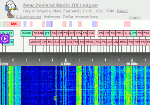From; THE AUSTRALIAN RADIO WORD, Page 46, September 1, 1937.
DX News and Views *** A page for letters from DX readers.
An International Log
A few words about dxing in New Zealand. VK’s on 20 metres have been coming in well for the last three months, and very seldom were signals less than Q5, R8-9. A few of the best were VK’s 4JU, 2XU, 2ADE, 2HF 2MH, 3AL, 2IQ, 3ZL, 5GM, 5AW and a few others, the best tone for music being VK5GM and 3AL. VK2XU and 4JU have the best all-round transmitters. My set does not go down to 10 metres, but I can receive VK2GU, 3WB and a few others on harmonics. There are a few ZL’s on 10 and 5 metres, but have not beard any yet.





